
Earned media
Earned media refers to brand exposure or publicity obtained through organic promotional efforts. Brands don’t pay for this content, nor do they have direct control over it.
What is earned media?

Earned media, also known as earned content, refers to the genuine recognition and coverage your brand receives from third-party sources. Customers leave reviews and recommendations, share your content, mention your brand, repost your material, and more — all because they genuinely love what you do.
This kind of exposure isn’t paid for or controlled directly by your brand. Instead, it’s the organic buzz that builds around your offerings, events, and products. You’ll see your brand naturally popping up in videos, images, and other popular examples, proving how much people appreciate what you offer.
Nowadays, savvy marketers are increasingly turning their focus to earned media opportunities. With the power of social media marketing and online public relations, they’re strategically positioning their brands to reach and engage with their target customers more effectively.
Earned media vs owned media vs paid media
Before we dive into the differences, let’s define owned media and paid media.
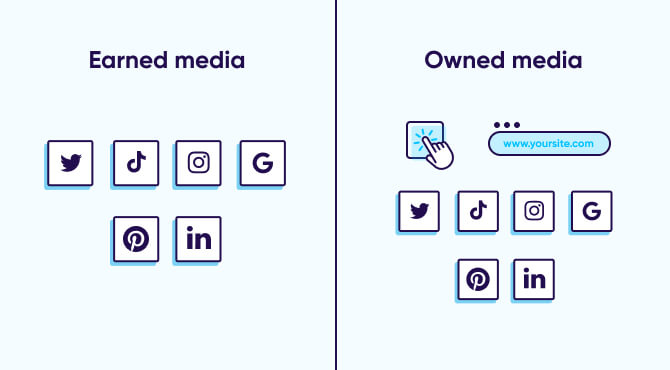
- Owned media refers to those exclusive web properties that you have full control over and that are uniquely tailored to your brand. With this complete autonomy, you can curate engaging content, deliver captivating stories, and foster meaningful interactions with your audience, leading to deeper connections.
The most familiar example of owned media is, of course, your website — the virtual hub where your brand story comes to life. Blog sites and social media channels also play crucial roles in representing your brand’s essence.
- Paid media encompasses marketing efforts where you pay to promote your brand. Its purpose extends beyond standalone promotion; it plays a crucial role in generating earned media and driving traffic to your owned media properties.
By investing in promoting content, you can achieve immediate visibility and broader exposure. Platforms like Facebook, Twitter, and LinkedIn offer excellent opportunities for paid advertising, which can amplify your content and direct traffic to your website. Collaborating with influencers is another effective tactic, allowing your products or services to reach a wider audience.
Here’s a table outlining the differences between earned, owned, and paid media:
| Definition | Source of exposure | Control by the brand | Cost to the brand | |
| Earned media | Organic, unpaid exposure gained through mentions, word-of-mouth, reviews, etc | User-generated content, and endorsements from customers, media, and influencers | No direct control | No cost |
| Owned media | Digital assets and channels owned and managed by the brand | Brand website, blog, social media handles | Full control | Investment in content creation, website maintenance, etc |
| Paid media | Promotional efforts that involve paying for advertising space or exposure | Advertisements, sponsored content, paid partnerships | Full control | Direct cost for ad placements, sponsorships, etc |
Integrating earned media with paid and owned media
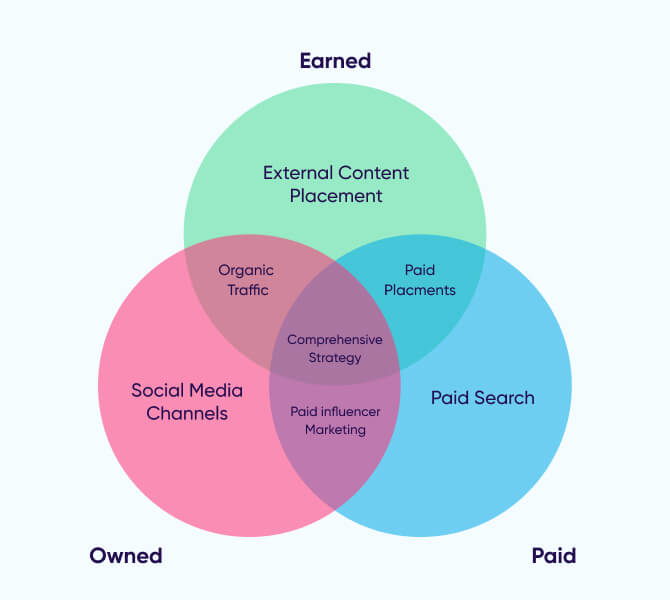
Each media type serves a distinct purpose in a well-rounded marketing strategy. But the best marketing campaigns often combine all three — earned media, owned media, and paid media — to achieve optimal results, such as:
- Maximized reach and impact: Integrating all three media types allows you to cover a wider range of audience touchpoints. Earned media generates word-of-mouth, owned media controls brand messaging, and paid media expands visibility to targeted demographics.
- Increased credibility and trust: Earned media’s authenticity, along with aligned owned media content, reinforces brand credibility. Paid media amplifies positive experiences, fostering trust and brand loyalty.
- Optimized marketing ROI: Combining media efforts aligns your marketing efforts to work harmoniously towards common goals. Leveraging earned and owned media prepares your audience for paid campaigns, leading to higher conversions and improved ROI.
Wondering how to seamlessly integrate your earned, owned, and paid media efforts? Here are some tips:
- Employ consistent brand messaging: Unify your brand message across all channels. Use owned media (like your website and social media) to show your unique voice and values, reinforcing your brand through earned and paid media efforts.
- Leverage user-generated content: Amplify user-generated content on owned platforms. Share positive reviews and testimonials to enhance credibility. Then use this content in paid campaigns to encourage engagement.
- Cross-promote content: Integrate media types by cross-promoting content. Share positive earned media coverage on owned platforms and consider promoting it through paid channels for maximum impact.
- Work with influencers: Collaborate with influencers who share your brand values. Have them talk about their experiences with your brand and also participate in paid campaigns for increased exposure, bridging the gap between earned and paid media.
- Measure performance: Use data analytics to track integrated media performance and optimize your marketing strategies. Measure earned media impact, monitor owned media engagement, and evaluate paid media ROI.
Why is earned media important?
Earned media offers a wealth of benefits that can greatly enhance your brand’s presence and reputation. Let’s take a closer look at these advantages.
1 — More brand exposure
Favorable mentions of your brand without paid promotion often lead to word-of-mouth publicity and other forms of engagement. This could include people following your social media accounts or showing deeper interest in your products and services. While earned media might not immediately result in direct purchases, it leaves a lasting impression on potential users that can lead to future conversions.
2 — Enhanced brand credibility
Praise from others automatically boosts your brand’s credibility and builds trust with your audience. Picture your brand featured in respected publications like The New York Times or The Wall Street Journal — it’ll enhance your reputation and borrow credibility from these sources, solidifying your market position and instilling consumer confidence in your brand.
3 — Increased brand loyalty
Earned media helps deepen the connection with your existing customers. When they come across positive coverage of your brand, it cements their loyalty and love for your products or services. As a result, they get even closer to becoming enthusiastic brand ambassadors, happily spreading the word about their fantastic experiences with your brand to others.
4 — Improved search engine rankings
Earned media offers more than just exposure and reputation benefits; it also has a substantial impact on your search engine rankings.
When you earn backlinks from authoritative and credible websites with a high domain or page authority, it significantly enhances your SEO efforts. Search engines value backlinks from reputable sources, and earning them through earned media coverage can positively influence your website’s ranking in search results.
Earned media examples
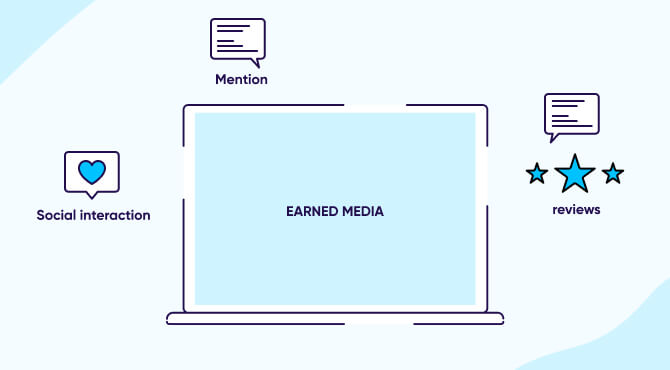
Next, let’s check out some of the most popular examples of earned media.
User reviews and ratings
Positive app ratings and reviews on platforms like Google Play Store or Apple App Store are earned media gold. Users’ genuine appreciation sparks valuable app promotion, influencing others to try your app.
Search engine results
Earned media and SEO work in unison in the realm of digital marketing. Valuable website content catches search engines’ attention, potentially landing your blog post on the first page of results. Mastering the right SEO strategies allows you to earn “free” organic placement, making high-quality, relevant content crucial for success.
Social media mentions and shares
When users share their experiences on social media, it generates earned media. Influenced by your brand’s behavior, product quality, and engaging content, organic mentions increase visibility and attract new users. Encouraging users to share their experiences through social media contests or using user-generated content campaigns can further amplify earned media.
Influencer endorsements
Influencers, especially in the tech or app niche, provide valuable earned media through authentic endorsements. When like-minded influencers share their positive experiences with your product, their audience perceives it as a genuine recommendation. The end result? Expanded reach and credibility.
Media coverage and blog features
Product or app coverage in tech blogs, industry news outlets, or online publications generates earned media. Features and articles discussing your product or service’s unique features, benefits, or impact lead to more brand exposure. Consider engaging with journalists and bloggers to secure more opportunities to build market authority.
User-generated content campaigns
User-generated content, such as tutorials, gameplay videos, or creative app use cases, demonstrates real experiences and fosters an enthusiastic community. Reposting and sharing this content on your official channels further amplifies earned media impact.
App awards and recognitions
Winning awards or being recognized in global rankings results in earned media, highlighting your product’s excellence and innovation. This external recognition not only boosts brand credibility, but also attracts media attention and new users seeking top-rated products and services.
Earned media limitations and challenges
Earned media, while a valuable aspect of marketing, does come with certain limitations. These include:
Unpredictability
Earned media is unpredictable, because you’re dependent on third-party sources to share their experiences about your app. There’s a chance of negative reviews or coverage spreading rapidly, potentially harming your brand’s reputation. For example, a popular gaming influencer endorsing your new gaming app may lead to a surge in downloads. But then, a negative review can equally harm your brand’s reputation, making it a double-edged sword.
Time and effort
Securing coverage from influential bloggers or journalists requires persistent outreach and showcasing the value of your app. And despite this, you can’t control the timing or content of the coverage. This makes trust-building with these external parties crucial, yet challenging and time-consuming. For new brands, this is especially daunting as they’re still unfamiliar with the market and need to establish themselves in the industry.
ROI measurement
Earned media boosts brand visibility and reputation, but directly linking it to specific financial outcomes is tricky due to the absence of precise metrics. For instance, featuring your health app in a prominent blog enhances awareness and credibility, but pinpointing the exact impact on downloads is complex. Word-of-mouth and other factors also influence user decisions, making it challenging to isolate earned media’s sole effect.
Earned media tactics and best practices
Building a positive brand reputation through earned media requires a genuine and customer-centric approach, focused on providing value to your audience and industry stakeholders. Here are some effective earned media tactics and best practices to build strong relationships with your audience:
1 — Build an earned media strategy
A robust earned media strategy makes it easier to achieve your marketing goals and measure outcomes. Here’s how you can create one for your business:
- Set clear goals: Define your marketing objectives, whether it’s boosting brand awareness, promoting a specific product or service, or targeting a new audience segment.
- Know your audience: Identify and understand your target audience to tailor your strategy effectively.
- Analyze content preferences: Conduct simple Google searches to research what B2B content your target audience prefers. Tools like BuzzSumo are also helpful to understand user preferences.
- Find the right partners: Seek out publications, review sites, influencers, and supporters that genuinely resonate with your brand values instead of resorting to paid coverage.
- Craft personalized pitches: Create tailored pitches for your targeted outlets and influencers, ensuring these align with their interests.
- Amplify on social media: Once you secure earned media coverage, maximize its impact by sharing it across your social channels. Encourage employees, investors, and stakeholders to promote the content too.
2 — Generate more earned media
Take action to generate more earned media by focusing on brand ambassadors. Identify enthusiastic fans on your social channels who actively engage with your content. Think: Facebook fans who frequently like and share your posts, Twitter followers who retweet you, or bloggers who mention your products.
Regularly engage with these brand ambassadors to cultivate their loyalty. Show gratitude by thanking them for their support and consider rewarding them with coupons or sharing their posts on your brand’s social channels. By cultivating these relationships, you can boost your earned media as these advocates authentically promote and advocate for your brand.
3 — Foster long-term relationships with journalists and influencers
To succeed in your earned media strategy, prioritize building strong connections with journalists and influencers. Avoid generic requests and instead, focus on cultivating genuine relationships. Understand their topics and target audiences, and use tools like HARO and Qwoted to connect with journalists seeking expertise.
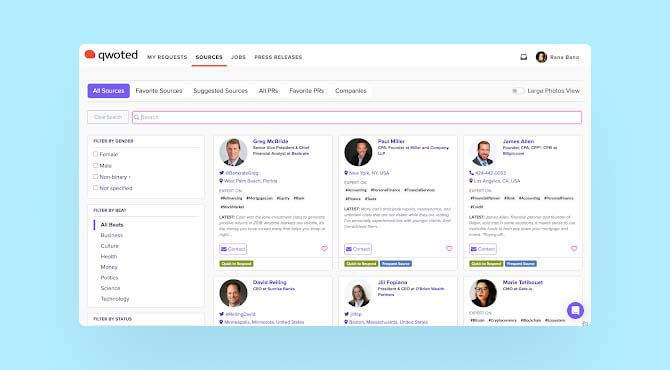
When approaching new contacts, thoroughly research their content preferences and follower engagement and then craft personalized pitches to match. Strengthen existing influencer partnerships by actively engaging with their content and sharing it when relevant. Remember, long-term collaboration is key for effective B2B influencer marketing, so invest in nurturing these relationships for lasting impact.
4 — Attend industry conferences and trade shows
At conferences and industry trade shows, seize the opportunity to interact personally with other brands, bloggers, journalists, and industry experts. This presents a chance to expand your network and secure earned media opportunities.
These events often have real-time social media coverage with unique hashtags for participants. Engaging with fellow attendees by mentioning their brands on social media, and receiving mentions in return, creates a collaborative environment. This approach can result in valuable earned media coverage and significantly enhance your brand’s presence.
5 — Leverage experiential marketing
Enhance your earned media through experiential marketing, a powerful approach centered around events and shared experiences with customers. These branded events often receive coverage from both traditional media outlets and online platforms.
To maximize this impact, implement an event-specific hashtag and actively engage with attendees’ posts through your social media manager, including retweeting, liking, and sharing. Don’t forget to encourage attendees to share their experiences on their own social networks, creating a ripple effect of organic promotion.
6 — Get more positive product reviews
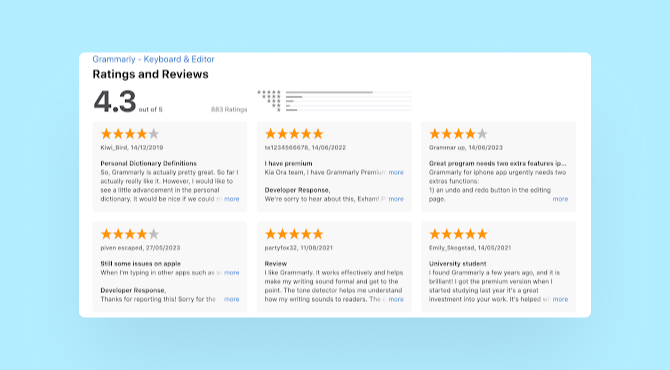
Positive product and service reviews on third-party sites make a big difference in how customers perceive a business. Case in point: a whopping 94% of people are more likely to use a company’s offerings if they read good reviews about them elsewhere.
Here are some actionable tips to drive website traffic and influence customer behavior in your favor using reviews:
- Keep it real: When it comes to reviews, authenticity is key. Stick to using feedback from real customers — no fake names or email addresses allowed!
- Spread the love: Don’t just keep those great reviews to yourself. Share them across different platforms like social networks, online forums, and blogs. This will help you reach a wider audience and build trust with your potential customers.
- Strategic publishing: Take charge and post those shining reviews on platforms like Amazon, Facebook, Yelp, TripAdvisor, or even on your own website. This way, you can proudly showcase all that positive feedback while having control over the content.
7 — Focus on generating more word-of-mouth recommendations
Word-of-mouth marketing is one of the most powerful forms of earned media, and the best part is, it happens organically. People will recommend your business without you even asking, and once that spark is ignited, it spreads like wildfire.
To maximize word-of-mouth publicity:
- Focus on building trust. Respond promptly to customer feedback and show you genuinely care about their experiences. Creating credibility through quick responses goes a long way in winning customers over.
- Provide exceptional customer experiences. Friendly, helpful, and responsive service creates lasting impressions and builds loyal relationships. Take the time to make every interaction special, and treat each customer like they matter.
- Ask for referrals. Those who already recommend your products or services are your best advocates. Offer incentives like discounts or coupons to fuel their enthusiasm and get more people talking positively about your brand.
Remember, word-of-mouth doesn’t happen overnight; it requires continuous effort and investment in building a positive reputation. But over time, these efforts lead to big rewards, and your business will thrive as satisfied customers become enthusiastic advocates, spreading positive word-of-mouth and boosting your brand’s reputation.
8 — Run a social media contest
Capture your audience’s interest with an engaging social media contest that generates excitement and buzz around your brand. To maximize impact, set clear rules and align the prize with your target audience’s interests.
You can amplify visibility by promoting the contest vigorously across all social channels. Don’t hesitate to collaborate with influencers for added reach while you’re at it. And once the contest ends, celebrate the winners and their entries on your social media platforms to create a ripple effect of engagement, forging lasting connections with your audience.
Key takeaways
- Earned media is genuine recognition and coverage a brand receives from third-party sources, like user reviews, social media mentions, and media features. It’s unpaid and not directly controlled by the brand.
- By integrating earned, owned, and paid media, brands can maximize reach and impact, increase credibility and trust, and optimize their marketing return on investment (ROI).
- Advantages of earned media include greater brand exposure, improved brand credibility, and increased brand loyalty. However, it can be unpredictable, time-consuming, and hard to measure accurately..
- Building a positive brand reputation through earned media requires a customer-centric approach. Set clear goals, know your audience, and craft personalized pitches for an effective strategy.
- To generate more earned media, focus on building and nurturing relationships with brand ambassadors, journalists, influencers, and other industry stakeholders. Genuine engagement and appreciation can lead to increased advocacy for your brand.
- Amplify earned media through tactics like industry events, experiential marketing, and social media contests. Focus on word-of-mouth recommendations, product reviews, and exceptional customer experiences to boost your brand’s reputation.



